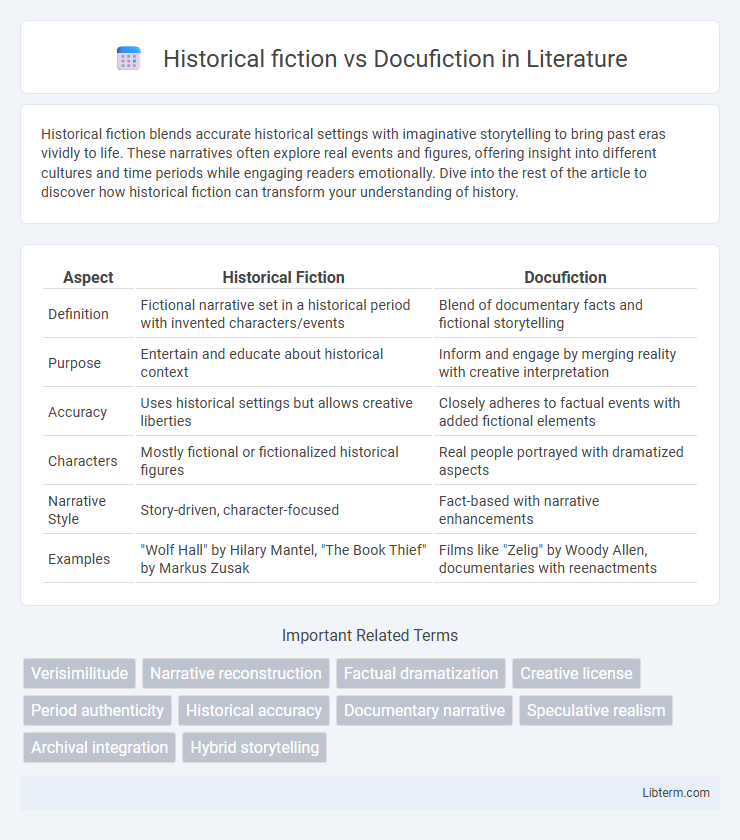Historical fiction blends accurate historical settings with imaginative storytelling to bring past eras vividly to life. These narratives often explore real events and figures, offering insight into different cultures and time periods while engaging readers emotionally. Dive into the rest of the article to discover how historical fiction can transform your understanding of history.
Table of Comparison
| Aspect | Historical Fiction | Docufiction |
|---|---|---|
| Definition | Fictional narrative set in a historical period with invented characters/events | Blend of documentary facts and fictional storytelling |
| Purpose | Entertain and educate about historical context | Inform and engage by merging reality with creative interpretation |
| Accuracy | Uses historical settings but allows creative liberties | Closely adheres to factual events with added fictional elements |
| Characters | Mostly fictional or fictionalized historical figures | Real people portrayed with dramatized aspects |
| Narrative Style | Story-driven, character-focused | Fact-based with narrative enhancements |
| Examples | "Wolf Hall" by Hilary Mantel, "The Book Thief" by Markus Zusak | Films like "Zelig" by Woody Allen, documentaries with reenactments |
Understanding Historical Fiction
Historical fiction blends imaginative storytelling with real historical settings, characters, and events, offering readers an engaging way to experience the past. This genre emphasizes narrative creativity while maintaining accuracy in cultural and temporal details to create authentic yet fictionalized accounts. Understanding historical fiction requires recognizing its balance between factual history and invented elements, distinguishing it from docufiction, which integrates documentary techniques to portray real events with dramatized reenactments.
Defining Docufiction
Docufiction blends documentary and fictional elements to present real historical events with dramatized storytelling, enhancing emotional engagement and narrative depth. Unlike historical fiction, which is primarily a creative interpretation set in the past, docufiction maintains factual accuracy by incorporating interviews, archival footage, or authentic settings. This hybrid genre is used in film and literature to explore historical truths while providing immersive, relatable experiences for audiences.
Origins and Evolution of Both Genres
Historical fiction originated in the early 19th century, blending imaginative storytelling with real events and figures to explore the past through a narrative lens, while docufiction emerged in the mid-20th century as a hybrid genre combining documentary film techniques with fictionalized elements to enhance realism and engagement. The evolution of historical fiction was influenced by authors like Sir Walter Scott, who popularized dramatic storytelling grounded in historical accuracy, whereas docufiction developed alongside advancements in cinematic technology, aiming to blur the lines between fact and creative interpretation. Both genres have continuously adapted, reflecting cultural shifts and audience demands for immersive yet informative portrayals of history.
Key Elements of Historical Fiction
Historical fiction centers on authentic settings, period-accurate details, and plausible characters inspired by real events, emphasizing narrative creativity within a historical framework. Docufiction combines documentary and fictional techniques, blending factual evidence with dramatized storytelling to convey historical truths more dynamically. Key elements of historical fiction include meticulous research, integration of real historical figures or events, and immersion in the cultural and social context of the chosen era.
Core Characteristics of Docufiction
Docufiction blends documentary realism with fictional storytelling, emphasizing authentic historical settings, real events, and factual accuracy while incorporating dramatized dialogue and character development. It often uses archival footage or reconstructed scenes to create an immersive narrative that educates as well as entertains. This genre prioritizes maintaining a credible representation of history while allowing creative freedom to explore perspectives and emotional truths.
Authenticity vs. Artistic License
Historical fiction emphasizes narrative creativity by blending imagined characters and events with authentic historical settings, allowing authors artistic license to explore emotional truths beyond strict factual accuracy. Docufiction prioritizes authenticity by integrating real archival footage, interviews, and genuine historical details to create a hybrid genre that blurs the lines between documentary and dramatization. The tension between authenticity and artistic license shapes how each genre represents past realities, with historical fiction favoring imaginative storytelling and docufiction committing closer adherence to factual evidence.
Narrative Techniques: Fact vs. Fable
Historical fiction employs imaginative storytelling to weave fictional characters and events into authentic historical settings, blending creativity with factual backdrop. Docufiction integrates real historical footage or documents with dramatized reenactments, aiming to present factual narratives enhanced by storytelling techniques. Both genres balance fact and fable, but historical fiction prioritizes narrative freedom while docufiction emphasizes factual accuracy through hybrid visual and textual methods.
Impact on Audience Perception
Historical fiction blends factual events with imaginative storytelling, allowing audiences to emotionally connect with the past while gaining a subjective understanding of historical contexts. Docufiction merges documentary techniques with fictional elements, creating a nuanced narrative that enhances credibility and immerses viewers in realistic scenarios. The impact on audience perception differs as historical fiction often prioritizes emotional engagement, whereas docufiction emphasizes authenticity and critical reflection on historical truth.
Notable Works in Historical Fiction and Docufiction
Notable works in historical fiction include Hilary Mantel's *Wolf Hall*, which vividly reimagines the life of Thomas Cromwell, and Ken Follett's *The Pillars of the Earth*, set in medieval England during the construction of a cathedral. In docufiction, films like *The Act of Killing* blend documentary footage with dramatized reenactments, while W.G. Sebald's *Austerlitz* merges historical research with fictional narrative to explore memory and history. Both genres uniquely immerse audiences by combining factual historical elements with creative storytelling techniques.
Choosing Between Historical Fiction and Docufiction
Choosing between historical fiction and docufiction depends on the reader's preference for narrative accuracy versus creative storytelling. Historical fiction prioritizes character-driven plots set within well-researched historical contexts, offering imaginative interpretations of past events. Docufiction blends factual documentation with fictional elements, appealing to those seeking a balance between factual history and dramatic narrative.
Historical fiction Infographic

 libterm.com
libterm.com